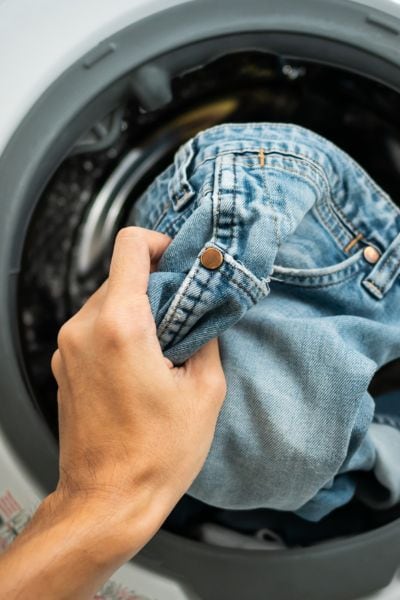Welcome to our comprehensive guide on dealing with post-wash stains on your favorite denim jeans.
We understand that life can be full of unexpected mishaps, from ink spills to food stains, and even the not-so-friendly encounter with paper scraps.
In this article, we’ve got you covered with effective solutions for various types of stains that can appear after your jeans have gone through the wash.
From tackling ink blots to erasing those pesky grass stains, we’ll walk you through the steps to ensure your jeans look their best.
So, whether you’re dealing with stubborn paper remnants or any other post-wash mishap, read on to discover how to restore your jeans to their pristine glory.
In this article, we will cover the following topics:
- Removing Ink Stains
- Dealing with Food Stains
- Handling Grease or Oil Stains
- Makeup Stains
- Dye Transfer Issues
- Grass Stains and Other Outdoor Stains
- Stubborn Paper Scraps
Quick Navigation
1. Removing Ink Stains
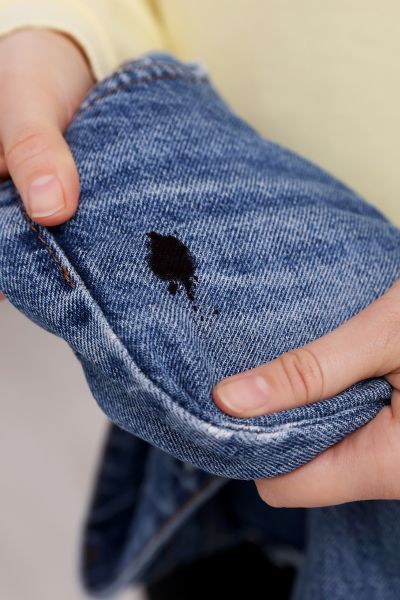
Ink stains can turn your jeans into an unintentional canvas of creativity, but worry not, we’ll show you how to master the art of stain removal.
Say goodbye to ink blotches and hello to spotless denim!
Rubbing Alcohol:
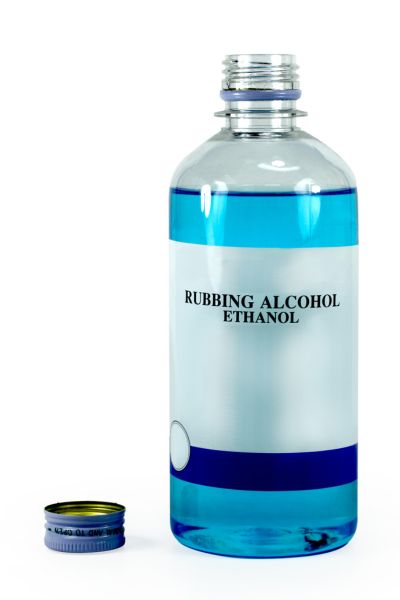
Rubbing alcohol dissolves ink stains because it is a powerful solvent, capable of breaking down the ink’s pigments. Its quick evaporation then carries away the dissolved ink, effectively removing the stain.
Additionally, rubbing alcohol’s non-polar nature is compatible with non-polar ink, making it a suitable and fabric-friendly choice for stain removal.
- Blot the stained area gently with a clean cloth to absorb excess ink.
- Dampen another cloth with rubbing alcohol and dab the ink stain. Remember to blot the stain instead of rubbing it to prevent any further spreading.
- After rinsing the area with cold water, assess whether the stain has disappeared. Repeat if necessary.
- Wash your jeans as usual.
Hairspray:

Hairspray removes ink stains because it contains solvents that dissolve the ink pigments, making them easier to lift from the fabric.
- Pat the affected region lightly with a clean cloth.
- Spray a bit of hairspray directly onto the ink stain, ensuring it’s well saturated.
- Blot the stain with a clean cloth to lift the ink.
- Rinse the area with cold water.
- Wash your jeans as usual.
Lemon Juice:
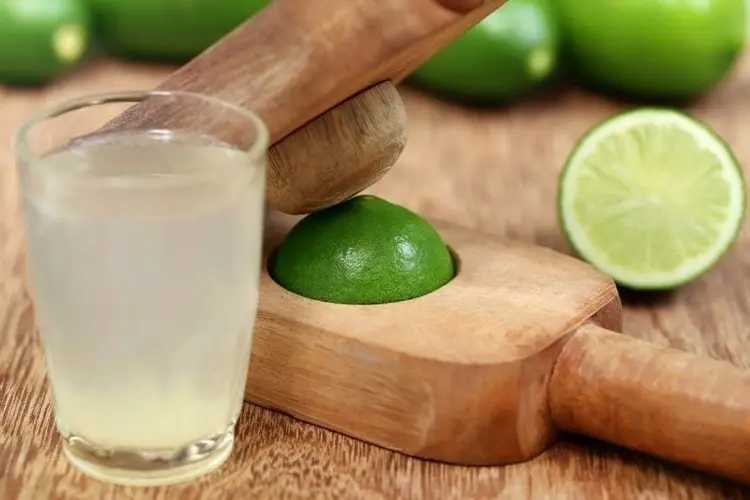
Lemon juice can remove ink stains due to its acidity. The acid in lemon juice helps break down and dissolve the ink pigments, making them easier to remove from the fabric.
- Create a paste by blending lemon juice with salt.
- Apply the lemon juice paste to the ink stain, ensuring it covers the stained area.
- Let it sit for a few minutes, allowing the lemon’s acidity to break down the ink.
- Rinse the area with cold water.
- Wash your jeans as usual.
2. Dealing with Food Stains
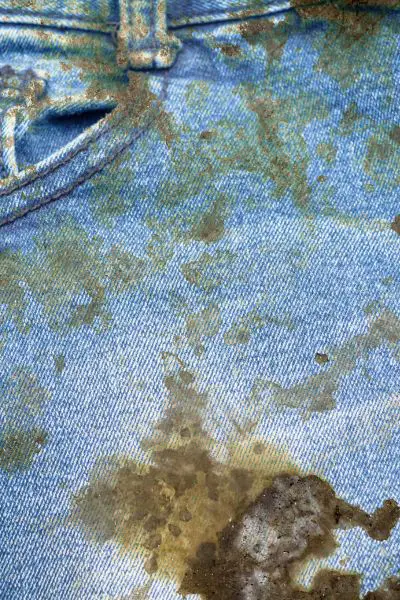
Whether it’s that splatter of spaghetti sauce or a sudden salsa mishap, food stains can sneak up on your jeans.
Dish Soap:
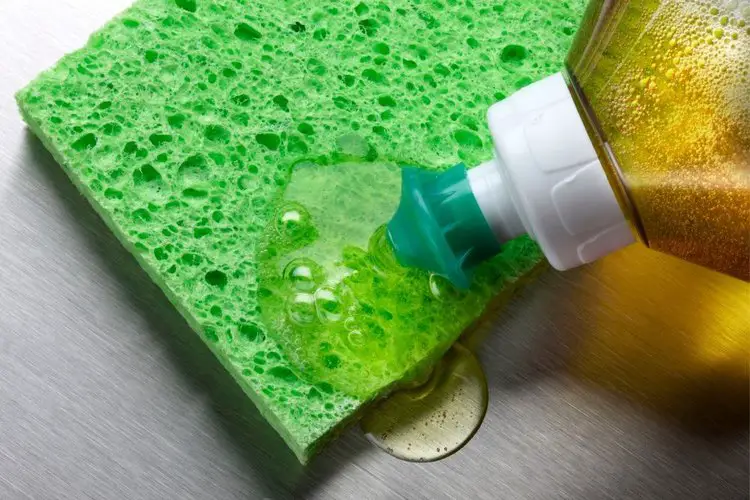
Dish soap is effective at dealing with food stains because it contains surfactants, which are molecules that can break down and lift away greasy or oily residues from the fabric.
These surfactants in dish soap help to emulsify and loosen food stains, allowing them to be easily rinsed away when you wash the fabric.
- Prepare a soapy solution by mixing a small quantity of dish soap with water.
- Apply the solution to the food stain and gently rub the fabric.
- Thoroughly rinse the stained area using cold water.
- Wash your jeans as usual.
White Vinegar:

Acetic acid helps to break down and dissolve food residues, particularly alkaline or basic stains. Vinegar can effectively deal with food stains because it contains acetic acid.
When applied to the stain, vinegar’s acidity helps neutralize and remove the stain’s particles, making it easier to wash away.
- Soak the stained area in a mixture of equal parts water and vinegar for about 30 minutes.
- Rinse thoroughly with cold water.
- Wash your jeans as usual.
Baking Soda:

Baking soda works against food stains due to its gentle abrasive nature. When mixed with water to form a paste, baking soda can act as a mild scrubbing agent that helps lift and loosen food residues from the fabric’s surface.
This abrasive action, combined with its ability to absorb odors, makes baking soda effective in handling food stains before washing.
- Form a paste using baking soda and water.
- Apply the paste onto the stain and delicately massage it in.
- Rinse the area with cold water.
- Wash your jeans as usual.
3. Handling Grease or Oil Stains
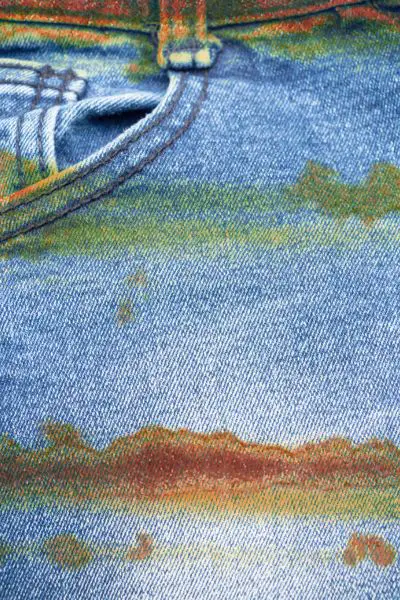
Grease and oil stains may feel like formidable foes, but we’ve got the secret sauce to defeat them. Join us in the battle against these slippery stains, and let your jeans shine, not shimmer!
Cornstarch:
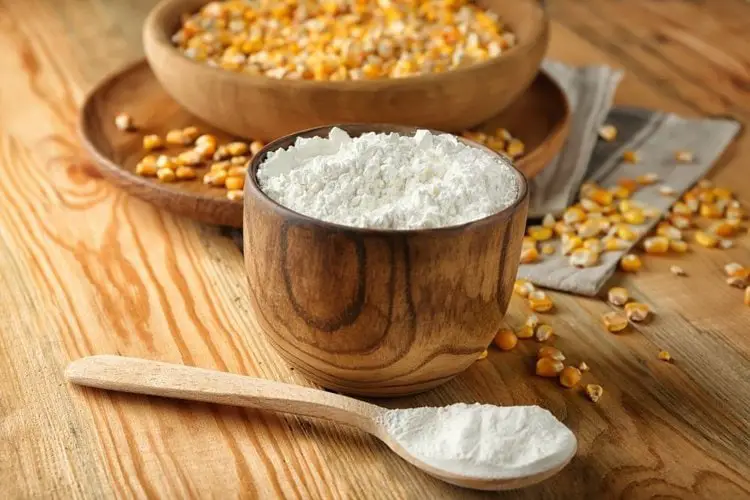
Cornstarch is a natural absorbent. When sprinkled onto a grease or oil stain, it absorbs and encapsulates the oil, making it less likely to spread further into the fabric.
It allows the oil to be lifted away from the fabric’s surface, making it easier to remove.
- Sprinkle cornstarch directly onto the grease or oil stain, covering it completely. Allow it to sit for at least 15 minutes to absorb the oil.
- Brush off the excess cornstarch.
- Apply a small amount of dish soap mixed with water to the stained area and gently rub the fabric.
- Rinse thoroughly with cold water.
- Wash your jeans as usual.
WD-40:
WD-40 is a versatile lubricant and solvent. Its chemical composition includes various compounds that can break down and dissolve grease and oil.
When applied to a grease stain, WD-40 helps to loosen and disperse the greasy residue, making it easier to blot and rinse away.
- Lightly blot the grease stain with a cloth dampened with a small amount of WD-40.
- Afterward, rinse the stained region meticulously with cold water.
- Wash your jeans as usual.
Talcum Powder:
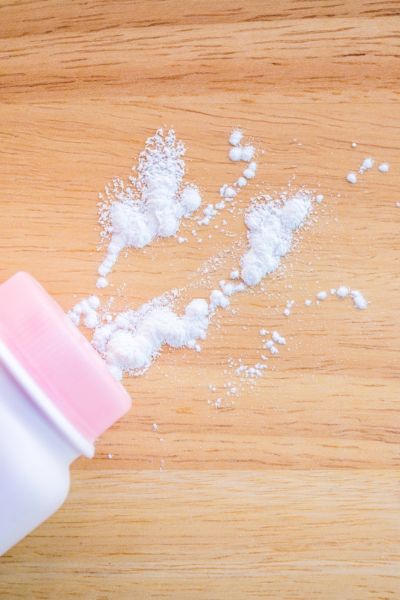
Talcum powder, also known as baby powder, has excellent oil-absorbing properties. When sprinkled onto a grease or oil stain, it absorbs the excess oil, reducing the stain’s visibility.
Additionally, talcum powder can help lift the oil from the fabric’s surface, facilitating its removal.
- Sprinkle talcum powder on the stain, covering it completely.
- Leave it undisturbed overnight to allow for oil absorption.
- Brush off the excess talcum powder.
- Wash your jeans as usual.
4. Makeup Stains
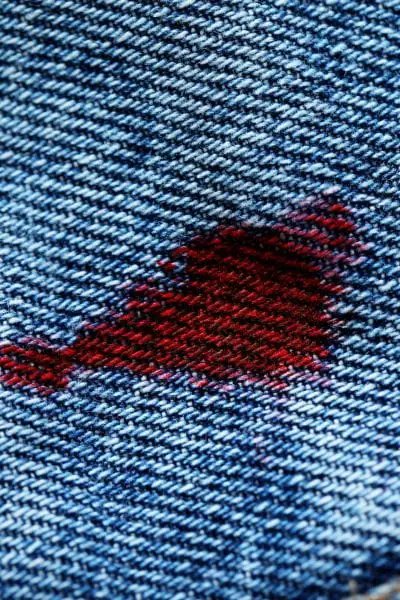
Makeup stains can be a glam lover’s nightmare, but don’t fret! We’ll reveal the beauty behind makeup stain removal.
Makeup Remover:
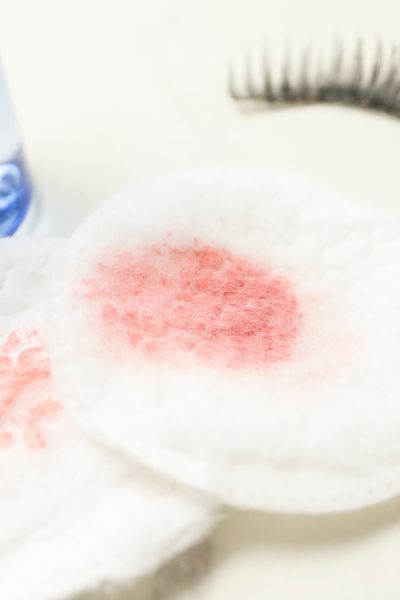
Makeup remover is specifically formulated to break down and dissolve cosmetic products, including makeup.
It contains ingredients designed to emulsify and lift makeup particles from the skin and other surfaces.
When applied to a makeup stain on fabric, makeup remover works similarly, breaking down and loosening the makeup particles, allowing them to be blotted or rinsed away.
- For fresh makeup stains, use a makeup remover or baby wipes to gently blot the stain. Exercise caution to avoid rubbing, as it might spread the stain.
- Rinse the area with cold water.
- Wash your jeans as usual.
Hand Sanitizer:
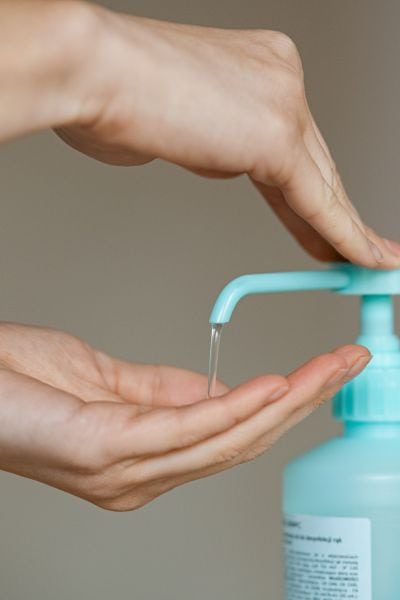
Hand sanitizer typically contains alcohol as one of its main ingredients. Alcohol is a solvent that can effectively dissolve many types of makeup, especially those with oil or grease-based components.
When hand sanitizer is applied to a makeup stain, the alcohol helps dissolve and break down the makeup, making it easier to remove.
- Apply a small amount of hand sanitizer to the makeup stain.
- Let it sit for a few minutes.
- Rinse the area thoroughly with cold water.
- Wash your jeans as usual.
Dishwashing Liquid:
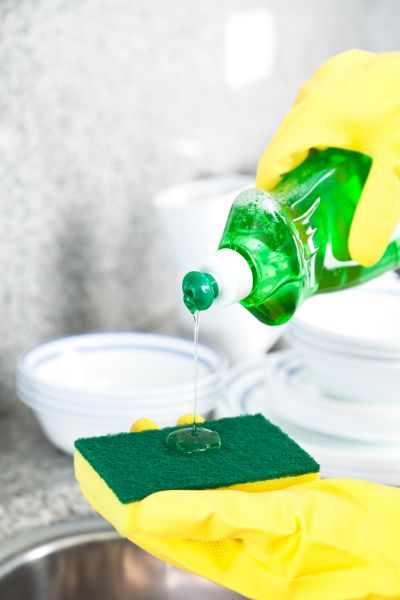
Dishwashing liquid is designed to break down and remove grease and oil residues from dishes. It contains surfactants that can emulsify and lift away oily substances.
When applied to a makeup stain, dishwashing liquid’s surfactants work to break down the makeup’s oily components, allowing them to be rinsed away.
- Combine a single drop of dishwashing liquid with water.
- Gently scrub the makeup stain with the soapy solution.
- Rinse the area with cold water.
- Wash your jeans as usual.
5. Dye Transfer Issues
Dye transfer issues can turn your jeans into a colorful puzzle, but we’ve got the pieces to put it back together.
Unravel the mystery of dye transfer with our expert guidance and keep your denim palette pristine!
Color Catcher Sheets:
Color catcher sheets work by absorbing and isolating loose dyes in the laundry. They prevent dye transfer by capturing and trapping dyes during the wash cycle.
Use color catcher sheets in your future washes to prevent dye transfer. Follow the product instructions.
Vinegar Soak Method:

The vinegar soak method helps address dye transfer by neutralizing alkaline dyes and setting colors.
Vinegar’s mild acidity prevents excess dye from bleeding into other fabrics during washing.
- Soak your jeans in a solution of one part vinegar and three parts cold water for about 30 minutes.
- Rinse thoroughly with cold water.
- Wash your jeans as usual.
Retouch Faded Areas:
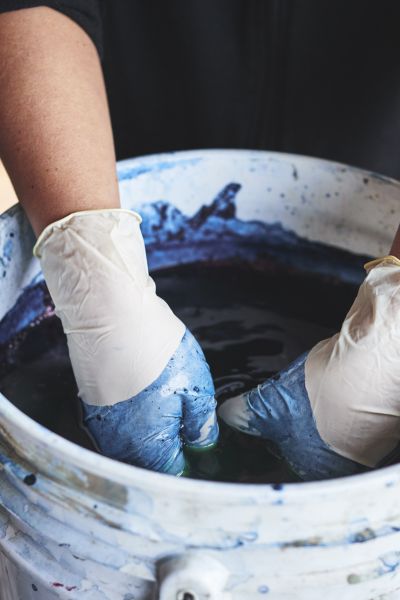
If your jeans have experienced significant fading, and you’re looking to bring back their original vibrancy, check out our detailed guide on How to Dye Denim Jeans.
It provides step-by-step instructions on rejuvenating your jeans’ color and ensuring they look as good as new.
6. Grass Stains and Other Outdoor Stains
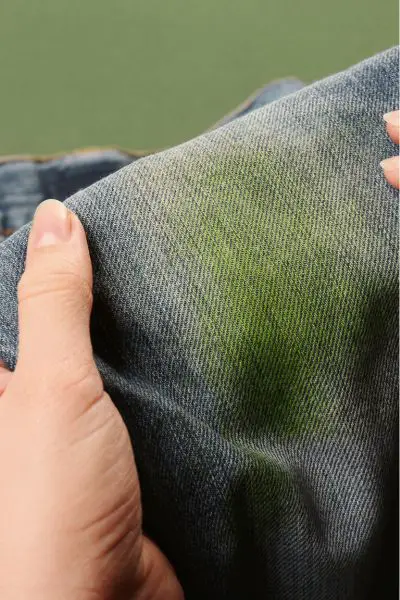
Outdoor adventures can leave your jeans with tales of grassy fields and muddy trails. Join us on an outdoor escapade where we’ll teach you the art of stain removal.
Say goodbye to grass stains and hello to the great outdoors – stain-free!
Liquid Laundry Detergent:
Liquid laundry detergent handles grass stains and outdoor stains with enzymes that break down stains and surfactants that lift particles.
- Apply liquid laundry detergent directly to the grass stain.
- Use an old toothbrush to gently scrub the affected area.
- Allow the detergent to rest on the stain for a duration of 10-15 minutes.
- Rinse the area thoroughly with cold water.
- Wash your jeans as usual.
Toothpaste:
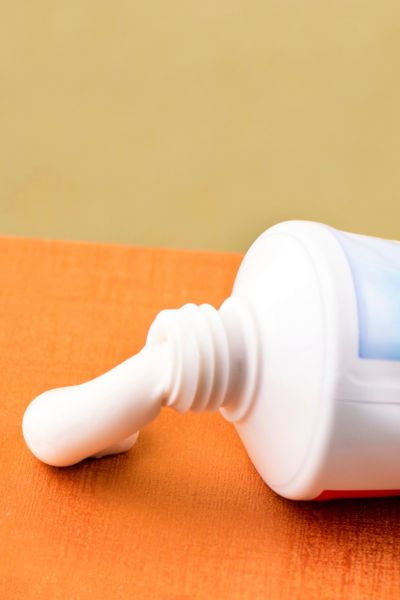
Toothpaste can remove grass stains from fabric due to its abrasive properties, mild bleaching effect, thick consistency, and the potential use of a toothbrush for mechanical action.
However, it’s essential to exercise caution and test on a small area before applying it to valuable or delicate clothing.
- Apply toothpaste to the grass stain.
- Use an old toothbrush to gently scrub the stained area.
- Rinse the area with cold water.
- Wash your jeans as usual.
Vinegar and Baking Soda:
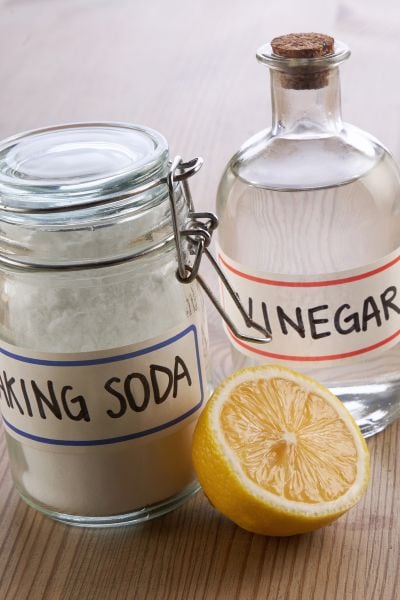
The vinegar and baking soda method is effective for grass stains because it combines the chemical action of the vinegar (breaking down the stain) with the mechanical action of baking soda (gentle scrubbing) to target and remove the stain at a molecular level.
Additionally, this method is safe for most fabrics and colors, as it doesn’t involve harsh chemicals or bleach.
It’s a gentle yet powerful way to treat grass stains without compromising the integrity of your clothing.
- Gently blot away excess grass and dirt from the stain using a clean cloth.
- Combine equal parts white vinegar and water in a bowl (e.g., 1/4 cup vinegar and 1/4 cup water).
- Dampen a cloth with the vinegar solution and blot the grass stain, working from the outside in.
- Allow the vinegar solution to sit on the stain for 10-15 minutes to break down the grass pigments.
- Lightly scatter some baking soda directly onto the stain. Gently scrub in a circular motion with an old toothbrush or soft brush.
- Rinse the stained area with cold water to remove vinegar and baking soda. Check if the stain is gone.
- Launder the clothing in cold water using a gentle detergent. Avoid hot water.
Check the stain before drying. If it’s still there, repeat the vinegar and baking soda treatment.
7. Paper scraps
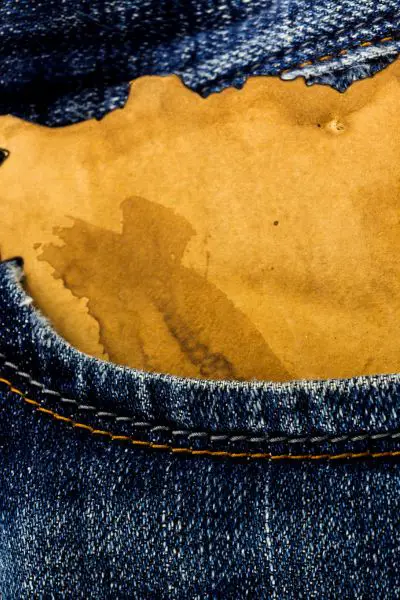
Much like their effectiveness in handling grass stains, Liquid Laundry Detergent, Toothpaste, and Ammonia Solution can also be used to effectively remove paper scraps from your jeans.
These solutions work by breaking down and lifting the paper remnants, making it easier to restore your jeans to their clean and tidy state.
In addition to the effective methods mentioned above, you can also employ alternative approaches to tackle those stubborn paper scraps.
Let the Jeans Dry, Shake, Brush, and Lint Roller:
Try letting the jeans dry, giving them a good shake, gently brushing with a soft-bristle brush, and using a lint roller or adhesive tape to lift away paper remnants.
- Let the jeans air dry completely.
- Shake the jeans to loosen any loose paper scraps.
- Use a soft-bristle brush to gently brush the jeans to dislodge the remaining paper bits.
- Use a lint roller or adhesive tape to pick up any paper scraps that remain on the surface.
- Repeat steps 1 to 4 as needed.
Additional Gentle Wash:
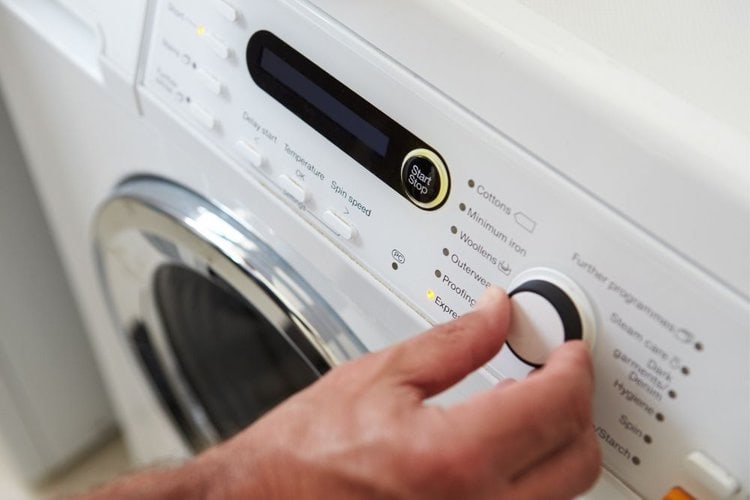
If needed, you can also opt for an additional gentle wash to ensure your jeans are paper-free and look their best.
- Wash the jeans again, using a gentle cycle and avoiding overloading the washing machine.
- Add a few dryer sheets to help attract any remaining paper bits.
- Air dry the jeans.
Last Thoughts
Stains on your jeans after washing don’t have to be a cause for distress. With these friendly and effective stain-removal techniques, you can keep your denim looking fresh and ready for more adventures.
So, don’t toss those jeans just yet – give these methods a try and get back to exploring the world in style!
Howdy y’all, and welcome to From The Guest Room, your ultimate guide to all things Western! I’m Jay Gatz, a lifelong cowboy boot enthusiast with over 5 years of experience in the Western style world. I’m excited to share my knowledge with you and help you discover the perfect cowboy boots and western gear to elevate your style. Let’s explore the rich history and timeless appeal of Western fashion together!
